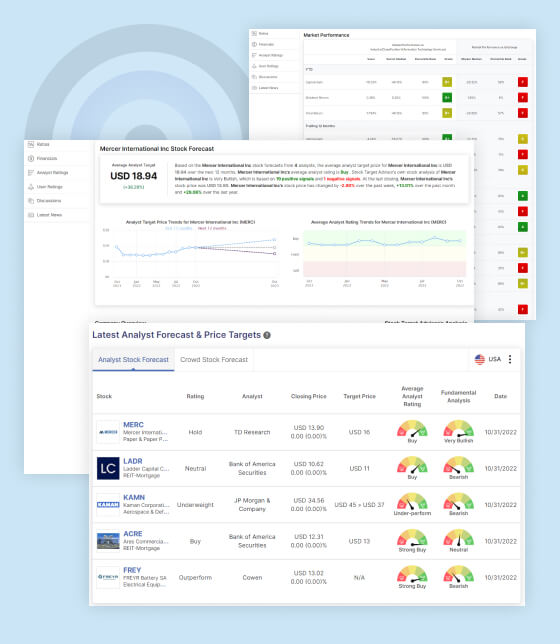In the world of investing, having a reliable roadmap is a massive advantage. This is where analyst stock ratings and targets become critical. But how do analyst stock ratings work, how accurate are stock price targets, and how should investors interpret them? In this comprehensive guide, we’ll explore how analyst ratings and analyst targets work and insights to help you use them effectively for investment decisions.
1. Decoding Analyst Stock Ratings
Analyst stock ratings serve as a valuable compass in the vast ocean of stocks, guiding investors toward potential opportunities. But how do analyst stock ratings work? Usually, these ratings range from 1 to 5, each signifying a different level of potential:
- Buy (1): This suggests that the analyst sees the stock as undervalued.
- Overweight (2): The stock is likely to outperform the market, according to the analyst.
- Hold (3): The stock is perceived as accurately valued.
- Underweight (4): The analyst predicts the stock might underperform.
- Sell (5): This rating indicates the analyst believes the stock is overvalued.
These ratings are derived from a thorough analysis of various factors, including the company’s financial health, industry outlook, and management effectiveness.
2. The Art and Science Behind Analyst Stock Targets
When analysts set a stock target, they’re essentially forecasting the stock’s price for a given time in the future, usually a year. This is based on meticulous research into the company’s financial health, industry conditions, and several valuation methods. These methods include:
- Discounted Cash Flow: This method values the company based on its projected cash flows.
- Comparable Company Analysis: This involves comparing the company with similar firms in the industry.
- Relative Valuation: This method compares a company’s value to other firms within the same sector.
3. Making the Most of Ratings and Targets
While these tools are undoubtedly useful, they should not be the sole factor driving an investor’s decisions. Here are some strategies for effective use of analyst ratings and targets:
- Seek Consensus: Rather than relying on a single analyst’s perspective, consider the average or consensus target.
- Track Record Matters: Always check the historical accuracy of the analyst. Platforms like Stock Target Advisor grade analysts based on their past accuracy, aiding in identifying the most reliable opinions. You can search analysts by their accuracy here .
- Understand the Reasoning: It’s crucial to understand why an analyst has set a specific target or rating. This context can offer valuable insights into their perspective.
- Diversify Your Research: While analyst ratings are beneficial, they should be complemented with personal research. Platforms like Stock Target Advisor combine analyst insights with robust algorithms, offering comprehensive data to aid investors in making informed decisions.
4. How Reliable are Analyst Ratings and Targets?
It’s important to remember that no prediction method is infallible. Studies indicate that analysts can sometimes lean towards over-optimism. However, platforms like Stock Target Advisor enhance the reliability of these tools by weighing track record into aggregate targets and ratings, and integrating automatic fundamental analysis to present a full picture.
5. Delving Deeper: Buy, Sell, and Hold Ratings
Analysts research public financial statements, listen in on conference calls, and engage with managers and customers of a company to form a comprehensive understanding of the company’s performance. Based on their findings, the analyst decides whether the stock is a “buy,” “sell,” or “hold.”
However, the analyst rating scale is more nuanced than the traditional classifications of “buy,” “hold,” and “sell.” For instance, “sell” can also be known as “strong sell,” and “buy” can be termed as “strong buy.” There are also a couple of new terms: “underperform” and “outperform.”.
6. The Scale of Ratings Explained
To fully understand the meaning behind each term, it is advisable to review the issuing firm’s rating scale. This is because not every firm adheres to the same ratings scheme. For instance, an “outperform” for one firm may be a “buy” for another, and a “sell” for one may be a “market perform” for another. Platforms such as Stock Target Advisor normalize analyst ratings to avoid confusion.
7. Understanding Price Targets
A price target is an analyst’s projection of a security’s future price. Price targets can relate to all types of securities, from complex investment products to stocks and bonds. The price target is based on assumptions about a security’s future supply and demand, technical levels, and fundamentals.
8. Factors Determining a Price Target
Different analysts and financial institutions use various valuation methods and consider different economic conditions when setting a price target. Fundamental analysts often discern the price target for a stock by creating a multiple of the price-to-earnings (P/E) ratio. In contrast, technical analysts use indicators, price action, statistics, trends, and price momentum to gauge the future price of a security.
9. The Power of Price Targets
Despite the most careful analysis, we cannot know for certain the price at which a stock will trade in the future. Nevertheless, when a prominent analyst changes their price target, it can have a significant impact on the price of a security. Accurately forecasting a security’s price movement is based on projection, probability, numerous tools, and lots of experience. However, even for the most seasoned professional, a price target is still a calculated guess.
10. The Role of Platforms like Stock Target Advisor
Stock research platforms like Stock Target Advisor normalize analyst ratings to avoid confusion. play a critical role in providing investors with a balanced approach to stock investing. They allow users to select analysts who are most accurate for a stock’s sector, thus debiasing the analyst ratings. Additionally, they combine analyst ratings with automatic fundamental analysis, providing a comprehensive view of potential investment opportunities.
Conclusion
Analyst stock ratings and targets offer a unique perspective on potential stock performance and serve as beneficial tools for investors. However, their true power is unlocked when used in tandem with personal research and other evaluation tools. With platforms like Stock Target Advisor , which normalize analyst ratings to avoid confusion, making informed investment decisions becomes a streamlined process, fostering a balanced and knowledgeable approach to stock investing.

STA Research (StockTargetAdvisor.com) is a independent Investment Research company that specializes in stock forecasting and analysis with integrated AI, based on our platform stocktargetadvisor.com, EST 2007.


































